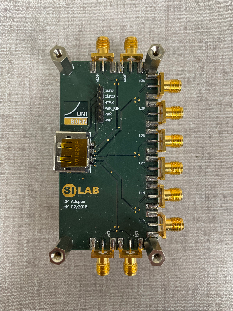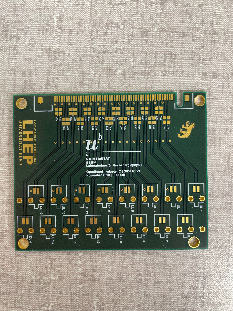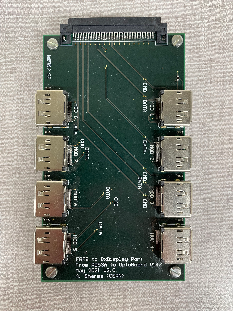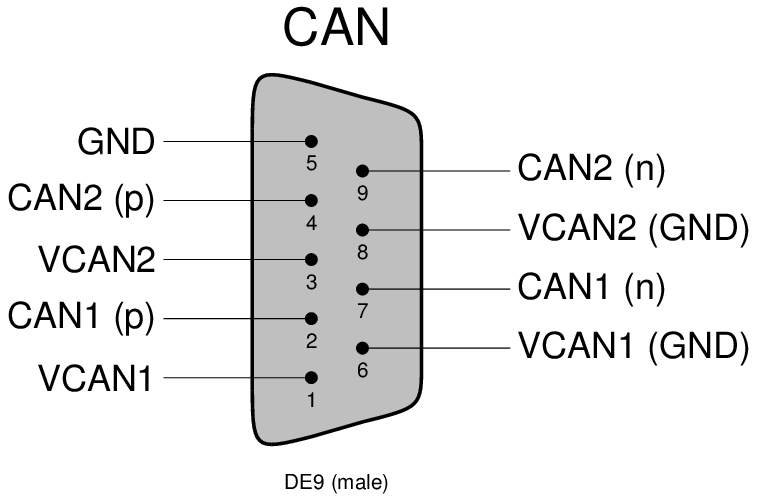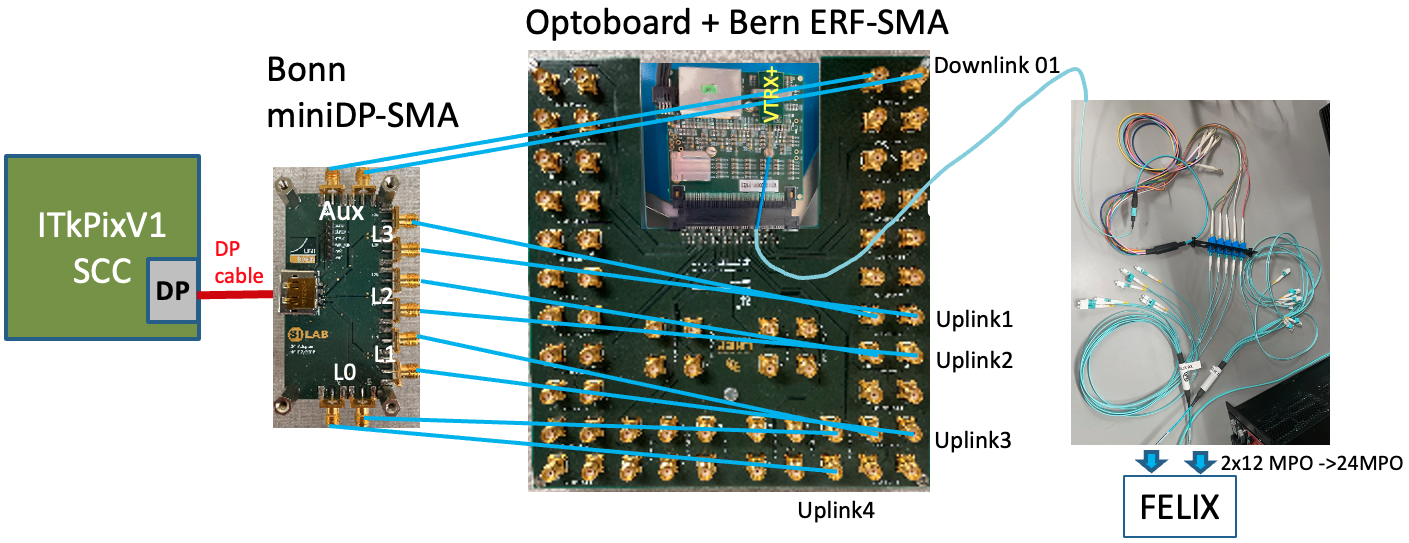Introduction:
The Optoboard System is the data aggregation and signal conversion stage of the ATLAS ITk Pixel data transmission chain. The basic working principle is:
- DATA: 6x 1.28 Gbps electrical links from the front-end modules are serialized into 1x 10.24 Gbps optical link and transmitted to the backend (FELIX).
- CMD: 1x 2.56 Gbps optical link with trigger and command are deserialized into 8x 160 Mbps electrical links and transmitted to the front-end (ITkPix). Also the Optoboard gets controlled through the optical link.
One Optoboard consists of:
- 4 lpGBTv1: one as a master available through IC, three as slaves controlled through I2C controller of the master. Manual/description here.
- 4 GBCR2: all controlled through lpGBT master I2C controller. Manual here.
- 1 VTRx+: controlled through lpGBT master I2C controller. Description here.
- 1 bPOL2V5 carrier board: houses the bPOL2V5 ASIC that converts 2.5 V to 1.2V. Datasheets here.
Specific for SLAC's test-Optopanel will be marked in red .
Mechanics:
- Up to 8x Optoboards are housed in one Optobox. One Optobox consists also of:
- 1 Powerboard: hosts 5 bPOL12V ASICs (conversion 9 V to 2.5 V) and 1 MOPS chip
- 1 Connectorboard: handles power distribution form the 5 bPOL12V to the 8 Optoboards according the SP chain powering/detector layout.
- Up to 28x Optoboxes (14x normal, 14x mirrored) are housed in one Optopanel.
- Each side of the ITk has 4 Optopanels.
Currently specific for SLAC IS demonstrator:
4x Optoboard V2.1 are housed in one Optobox. This Optobox is housed in a Test-Optopanel.
Interfaces:
Please refer to our Interface Document here. All the connectors of the Optoboard System is explained there.
Adapter boards:
| ERF-SMA (routing, schematics) from Bern | DP-SMA (routing, schematics) | ERF-twinax from Bern | ERF-8x DP (routing, schematics) |
|---|---|---|---|
Schematics:
All schematics for all of Berns designed PCBs can be found here.
Optoboard system support:
We collect support requests and general questions on our Mattermost channel Bern-Optoboard (invite link). Your contacts as of Aug. 2022 are Aaron O'Neill and Daniele del Santo.
Optoboard software for FELIX:
We created a repository with scripting software to easily configure the Optoboard: https://gitlab.cern.ch/bat/optoboard_felix. A lot is documented in the readme and wiki of the repository.
The repository is located in the directory:
/home/itkpix/optoboard-system
To configure an Optoboard V2.1 with the default configurations found simply run these scripts:
In a first terminal felixcore:
cd /home/itkpix/felix-sw/flx-sw-2022-08-11 # or another felix-sw version source setup.sh x86_64-centos7-gcc11-opt/felixcore/felixcore -d 0 --data-interface lo --elinks 0,4,8,12 # starts felixcore, check your links!
Note that the elinks might change according your connectivity scheme. More information from Ismet here.
In a second terminal do:
cd /home/itkpix/optoboard_felix source flx_opto_setup.sh # if FELIX server restart or stuck: source flx_opto_setup_fresh.sh cd optoboard_felix python quick_start.py -v 1.3 -s 00000000 -G 0 -d 0
The -s specifies the serial number used (00000000 is the default one for Optoboard V2.1), -G is the link number of FELIX and -d the FELIX device. If -s is set to 00000000 and -v 1.3, optoboard_felix sends the parameters in the config ~/optoboard_felix/configs/optoboard_lpgbtv1_gbcr2_vtrxv1_3_default.json to the lpGBTs, GBCR and VTRx+. Check the FELIX documentation or the optoboard_felix readme for more information on this.
If you do flx-info link you should see that respective link aligned. If you do flx-info podpower you should see something like this (if single Optoboard outside test-Optopanel is connected similarly):
Optical power (Receive=RX or Transmit=TX) of channel in uW:
| 0 | 1 | 2 | 3 | 4 | 5 | 6 | 7 | 8 | 9 | 10 | 11 |
|=========|=========|=========|=========|=========|=========|=========|=========|=========|=========|=========|=========|
1st TX | 983.30 | 986.10 | 892.10 | 970.00 | 937.50 | 1009.70 | 916.20 | 970.30 | 920.00 | 960.80 | 924.40 | 958.50 |
1st RX | 946.80 | 790.20 | 870.50 | 761.80 | 0.00 | 0.00 | 0.00 | 0.00 | 0.00 | 0.00 | 0.00 | 0.00 |
After fibre fanout installation:
After the fibre fanout is installed, configuring the Optoboards will look similar to this:
python quick_start.py -v 1.3 -s 00000000 -G 0 -d 0 python quick_start.py -v 1.3 -s 00000000 -G 1 -d 0 python quick_start.py -v 1.3 -s 00000000 -G 2 -d 0 python quick_start.py -v 1.3 -s 00000000 -G 3 -d 0
Or with the separate configs that are created in ~/optoboard_felix/configs:
python quick_start.py -v 1.3 -c /configs/2400003.json python quick_start.py -v 1.3 -c /configs/2400006.json python quick_start.py -v 1.3 -c /configs/2400007.json python quick_start.py -v 1.3 -c /configs/2400011.json
Note that in this case the connected FELIX fibre channel has to be set inside the configuration file as described in the readme here.
In a currently ongoing effort by Bern PhD student Daniele dal Santo, the software will be integrated into the ITk demonstrator software itk-demo-sw.
Further tools:
flpgbtconf: FELIX low level tool to communicate with (and only with) the lpGBT master directly. flpgbtconf -h will give you help on the tool, here an example:
flpgbtconf -1 -I 0x74 -G 0 -d 0 ULDATASOURCE5_DLG0DATASOURCE 0x1 # sets CMD from data to PRBS7 pattern on EPTX00 and EPTX02
-I 0x74 is the address for the lpGBT and the option -1 for the lpGBT version 1. Consult the lpGBT manual for all the various register names. There are many more options with FELIX, consult the FELIX user manual.
Test-Optopanel at SLAC:
The test-Optopanel houses one Optobox with 4 Optoboards. It has a twinax inlet (round) and a fibre outlet (rectangle). The Optobox is mounted on a cooling plate with two 8 mm pipes.
A collection of photographs from the test-Optopanel and its sister at CERN SR1 can be found here. See also this Twiki here of the SR1 test-Optopanel which has similiar information (but some very different configurations).
Optoboards:
| slot: | OB1 | OB2 | OB3 | OB4 | OB5 | OB6 | OB7 | OB8 |
|---|---|---|---|---|---|---|---|---|
| serial: | 2400006 | - | 2400003 | - | 2400007 | - | 2400011 | - |
| powering from bPOL: | A | A | B | B | C | C | D | D |
| idle current* [mA] | 182 | - | 165 | - | 168 | - | 174 | - |
| FELIX link: | ||||||||
| Current Location | SLAC | ANL | OSU | SLAC |
*after power-up and inside the test-Optopanel with 9.0 V supplied. If powered outside the test-Optopanel directly on the connector with 2.5 V expect a current ~415 mA.
Connectors:
Check the above interfaces document for more detailled description.
Banana plugs are labelled according to powered bPOL12V.
Cooling and dry air inlet/outlet: FESTO 8 mm
DCS:
Currently no MOPS is mounted on the Powerboard inside the test-Optopanel (due to availability). We will ship one as soon as we got our hands on them.
SLAC Single Optoboard Test Setup
The initial single optoboard setup used for the early SLAC tests with single chip cards is summarized in the diagram below:
| Bonn miniDP-SMA | Bern ERF-SMA | VTRX+ fiber | FELIX fiber |
|---|---|---|---|
| AUX | DOWNLINK 01 | red (7) | TX 1 |
| LN3 | L1 UPLINK 01 | white (6) | RX 1 |
| LN2 | L1 UPLINK 02 | slate (5) | RX 2 |
| LN1 | L1 UPLINK 03 | brown (4) | RX 3 |
| LN0 | L1 UPLINK 04 | green (3) | RX 4 |
Note that the Optoboard VTRX+ fiber pigtail MT ferrules connection to MPO12-LC fiber splitter is a simple slip on which requires careful manual recognition of right polarity (see ITkPixV1 readout page) which can easily slip off but prevents accidental large force breaking the fiber. It is advisable to always check the link light level with flx-info podpower to verify the fiber link is healthy (>700uW). How the VTRX+ fiber pigtail lines are structured is described in the Optosystem Interface document AT2-IP-GM-0010 (Table 4) with 5 out of 12 fibers active per optoboard. How the FELIX MPO24 port is structured and fanout with MPO24->2xMPO12→LC splitters are described in the FELIX readout and Direct FELIX confluence pages.
Some Useful Links
- FELIX JIRA (Oct/22) on optoboard + ITkP{ix readout setup
- CERN mattermost Bern-Optoboard channel
- Talk (Dec/9/2022) by Angira Rastogi on Optoboard-FELIX setup at LBNL

